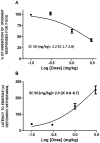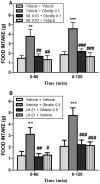Ghrelin-induced orexigenic effect in rats depends on the metabolic status and is counteracted by peripheral CB1 receptor antagonism
- PMID: 23565287
- PMCID: PMC3615061
- DOI: 10.1371/journal.pone.0060918
Ghrelin-induced orexigenic effect in rats depends on the metabolic status and is counteracted by peripheral CB1 receptor antagonism
Abstract
Ghrelin is an endogenous regulator of energy homeostasis synthesized by the stomach to stimulate appetite and positive energy balance. Similarly, the endocannabinoid system is part of our internal machinery controlling food intake and energy expenditure. Both peripheral and central mechanisms regulate CB1-mediated control of food intake and a functional relationship between hypothalamic ghrelin and cannabinoid CB1 receptor has been proposed. First of all, we investigated brain ghrelin actions on food intake in rats with different metabolic status (negative or equilibrate energy balance). Secondly, we tested a sub-anxiogenic ultra-low dose of the CB1 antagonist SR141716A (Rimonabant) and the peripheral-acting CB1 antagonist LH-21 on ghrelin orexigenic actions. We found that: 1) central administration of ghrelin promotes food intake in free feeding animals but not in 24 h food-deprived or chronically food-restricted animals; 2) an ultra-low dose of SR141716A (a subthreshold dose 75 folds lower than the EC50 for induction of anxiety) completely counteracts the orexigenic actions of central ghrelin in free feeding animals; 3) the peripheral-restricted CB1 antagonist LH-21 blocks ghrelin-induced hyperphagia in free feeding animals. Our study highlights the importance of the animaĺs metabolic status for the effectiveness of ghrelin in promoting feeding, and suggests that the peripheral endocannabinoid system may interact with ghrelińs signal in the control of food intake under equilibrate energy balance conditions.
Conflict of interest statement
Figures



References
-
- Ariyasu H, Takaya K, Tagami T, Ogawa Y, Hosoda K, et al. (2001) Stomach is a major source of circulating ghrelin, and feeding state determines plasma ghrelin-like immunoreactivity levels in humans. J Clin Endocrinol Metab 86: 4753–4758. - PubMed
-
- Kojima M, Hosoda H, Date Y, Nakazato M, Matsuo H, et al. (1999) Ghrelin is a growth-hormone-releasing acylated peptide from stomach. Nature 402: 656–660. - PubMed
-
- Sakata I, Nakamura K, Yamazaki M, Matsubara M, Hayashi Y, et al. (2002) Ghrelin-producing cells exist as two types of cells, closed- and opened-type cells, in the rat gastrointestinal tract. Peptides 23: 531–536. - PubMed
-
- Kamegai J, Tamura H, Shimizu T, Ishii S, Sugihara H, et al. (2001) Chronic central infusion of ghrelin increases hypothalamic neuropeptide Y and Agouti-related protein mRNA levels and body weight in rats. Diabetes 50: 2438–43. - PubMed
-
- Nakazato M, Murakami N, Date Y, Kojima M, Matsuo H, et al. (2001) A role for ghrelin in the central regulation of feeding. Nature 409: 194–8. - PubMed
Publication types
MeSH terms
Substances
LinkOut - more resources
Full Text Sources
Other Literature Sources

